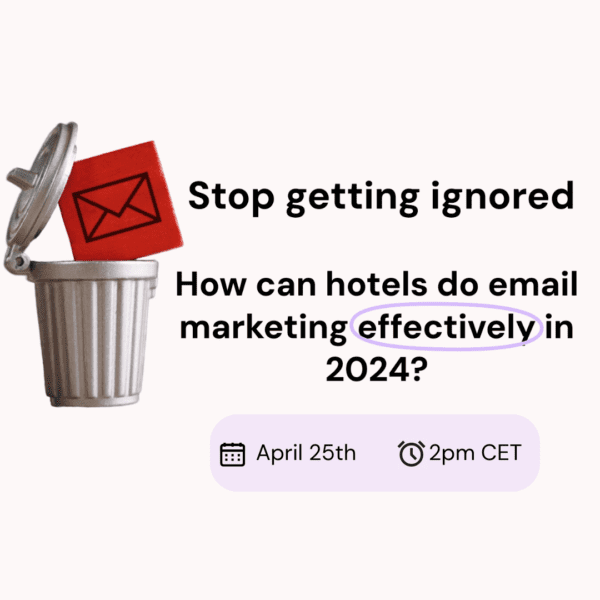 Email marketing is a vital part of a hotel’s CRM efforts, but for many, it remains a complex, uncharted landscape. The good news is, it’s not as hard as it seems. These days, a wide array of user-friendly platforms make it easy to maintain and manage an email list, design collateral, automate sends, and gather analytics. However, it’s important to keep some important best practices in mind. So, without further ado, here’s our list of the top five email marketing best practices for hoteliers.
Email marketing is a vital part of a hotel’s CRM efforts, but for many, it remains a complex, uncharted landscape. The good news is, it’s not as hard as it seems. These days, a wide array of user-friendly platforms make it easy to maintain and manage an email list, design collateral, automate sends, and gather analytics. However, it’s important to keep some important best practices in mind. So, without further ado, here’s our list of the top five email marketing best practices for hoteliers.
1. You’re only as good as your list
Good email marketing starts with a good email list. However, many hotels are stuck with an old list that’s been compiled over the years. This can lead to a huge variance in how much information they have on their subscribers. And unless the hotel has been practicing good data hygiene, there could be quite a few inactive and unresponsive users, which not only distorts the analytics needed to optimize a hotel’s email marketing efforts, but prevents accurate segmentation and personalization.
Maintaining a quality email list requires a two-pronged approach. First, you need to clean up what you have. If a subscriber hasn’t opened one of your emails in six months, a year, or more, it’s time to send a re-engagement campaign to see if those subscribers are still interested. If there’s no response, you can feel confident removing them from your list. In addition to removing inactive users, you need to ensure the quality of new subscribers. Make sure that your sign-up forms are asking for the information you’ll need to personalize and segment going forward, like location and travel preferences.
2. Segment and personalize
Once you have a healthy list of responsive subscribers and adequate information on them, you can begin to segment your campaigns. Being able to differentiate between your customers, such as those that stay on business and those that come for a family vacation, for example, will allow you to send news, information, and relevant offers that will resonate with them. You can expect to see a significant increase in engagement as a result.
To go a step further, we highly recommend personalizing your emails. From simply including a user’s first name in the subject line to tailoring content based on gender, age, location, or behavior, personalization almost always leads to higher engagement. Try using personalized emails to thank customers after booking, upsell add-ons before arrival, or invite them back after completing their stay in order to show that you value their business and pay attention to what they’re doing.
3. Know your goal and make it clear
There are many reasons to send emails to your subscribers. Different campaigns are designed to funnel traffic to specific web pages, drive bookings, generate engagement, or accomplish other goals. Whichever result you have in mind, make sure you’re clear on the purpose of your campaign, and resist the urge to try too much. Sticking to one goal will not only promote better results, but it will make it easier to analyze data and optimize future campaigns.
Having a clear focus will also help you create better content. Make sure your subject line, imagery, and body content all reinforce the same message, and limit your design to one clear, prominent call-to-action (CTA) button. If there’s anything else you want to promote, design a separate email and send each one to the appropriate segment of your list.
4. Content is key
Having a good offer or bit of news to share with your subscribers won’t go far if you don’t make it interesting. Your subscribers are likely receiving emails from a wide range of businesses, so the competition for attention in their inboxes is fierce. As a result, the quality of content in marketing emails has increased significantly over the past couple years. This doesn’t mean you should be intimidated, but it does mean that you need to give your content the TLC it deserves.
Persuasive, engaging content will always lead to better results. Avoid simply stating what you want to say — your messaging should be funny, entertaining, creative, or presented with a personality that your subscribers identify with. Persuasive content goes beyond just copy, too. Not only can images add an eye-catching visual dimension to your emails, but pictures can convey certain messages in a way that’s much quicker to digest.
5. A/B Test, A/B Test, A/B Test
A/B testing is not just a good idea, it should be considered a necessary part of any email marketing campaign. The idea is simple: You send two different versions of your email, such as one with emojis in the subject line and one without, and you see which one performs better. Not only will you systematically optimize your collateral, but you’ll learn about the preferences of your subscribers and develop best practices for the future.
Every element of your emails can be A/B tested, from the length and wording of subject lines, preheaders, and body content to the look of your design, imagery, and CTA buttons. Once you’ve identified the elements you want to test, prioritize them based on the impact you think they’ll have, and come up with a clear prediction of which option you think will perform better. As the results come in, pay close attention to open rate, click-through rate, click-to-open rate, and conversions, and use that information to inform future campaigns.
Conclusion
With these five principles in mind, you’re all set to take command of your email marketing efforts. However, there’s no need to do it all at once — even if you’ve only just started building your email list, or plan to implement A/B testing and personalization further down the line, keeping these principles in mind will make sure you’re on a good path to success. So be creative, have fun, and happy sending!


















